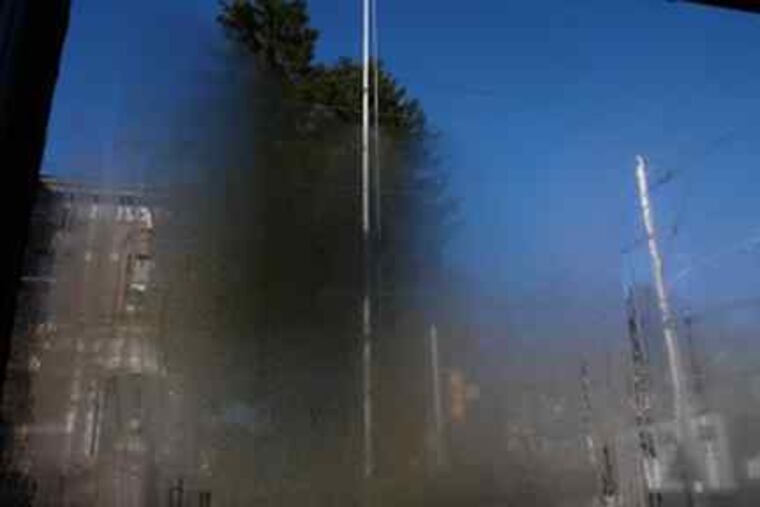James A. Michener Museum shows movie costumes, offers 'screen test'
'Icons of Costume: Hollywood's Golden Era & Beyond" at Doylestown's Michener Museum is challenging its viewers to be like the tenor who hits a higher note than the one in the score, by offering them their own star turns at the exhibition.

'Icons of Costume: Hollywood's Golden Era & Beyond" at Doylestown's Michener Museum is challenging its viewers to be like the tenor who hits a higher note than the one in the score, by offering them their own star turns at the exhibition.
Besides featuring more than 50 pristine costumes and objects from films of the 1940s through '90s, the show invites interested attendees to take a "screen test" - selecting props and costumes used in such roles as Dorothy from The Wizard of Oz and Arnold Schwarzenegger's Terminator 2 cyborg - then going before an on-site camera to be photographed in their "parts."
Whether or not you avail yourself of this entertaining option, the display offers a rare opportunity to examine closely the works of some very able costume designers, some of whom influenced American fashion over the years. Particularly intriguing are the hoopskirted, appliqued velvet ball gown designed by Bridgehouse for the 1940 film The Son of Monte Cristo, and Marilyn Monroe's exotic gold lamé dress by Travilla for Gentlemen Prefer Blondes in 1953.
Don't fix it
Exhibits by Philadelphia's Wood Turning Center start a flow of ideas, and it's happening again with its latest traveling juried show, "Challenge VII: dysFUNctional," now at Montgomery County Community College in Blue Bell.
Acting in response to evaluation of its programming by prominent curators, one in London, the other in Seattle, the Wood Turning Center recently rethought its role as a "supportive, celebratory and promotional organization." It now sees itself as "surprising, critical and provocative." Founded in 1986, it has never stood still, always looking to take the effective next step, its outreach international from the start.
Over all, this display by 30 artists from the United States, Italy, France, England, Canada, and Australia is a fascinating, optimistic, and humorous look at wood-turning artistry, supplemented with additional media. It offers stimulus for future shows under the new mandate of inclusion, thus broadening range and audience.
Of the many artists who threw themselves enthusiastically into creating dysfunctional pieces, Jordan Gilman, William Leete, and Jennifer Marsh produced especially distorted and contorted chairs. Michael Brolly's five wooden dinner plates - collectively titled Ghosts of the Hand of the Fathers That Rock the Cradle, a reference to his Irish ancestry - are perhaps the show's most surprising pieces in their depth of feeling about Irish "show plates" displayed at home.
The exhibit is the very fitting highlight event for the debut of the college's spacious new Art Barn, designed to resemble a real barn.
Photos at the mill
Spencer Saunders is still proudly presiding over the annual Phillips' Mill juried photo classic he cofounded 18 years ago, his zest undiminished. Digital images now dominate among 154 photos by 103 photographers from five states (including 69 Pennsylvanians), their work chosen from 859 entries. Yardley's Barbara Warren won best-in-show for her estimable Washington state semi-abstract digital landscape with rolling hills. This year I detect slightly more attention than usual to poignant human subjects, suggested by James Pryor's reverent attitude toward old people; the Hopewell photographer won for best body of work. Similar were Sam Popkin of Doylestown's soldiers in Lebanon, and Derek Jecxz of Yardley's Labrador folks.
What a wonderfully picturesque setting this 1756 William Lathrop gristmill provides! It's a delight to see the burgeoning development of this important show that Phillips' Mill Community Association so wisely sponsors.
A good start
The current attractive 20-artist regional painting show "Landscape Into Abstraction," curated by Marianne Mitchell at Historic Yellow Springs, reminds me favorably of this art center's long-ago achievements. It staged cutting-edge sculpture exhibits in the 1960s before Penn's Institute of Contemporary Art existed; also notable was its series of group photo shows curated by Stephen Perloff.
For the future, let's hope Yellow Springs (which has now merged, art-wise, with Chester Springs Studio) won't be content to settle back under its new director to a diet of "safe" money-raising sales of lightly juried popular art. That indeed would be dull, given the giant steps in community service taken by comparable facilities - Wayne Art Center, Main Line Art Center, Abington Art Center, and Wallingford Community Arts Center - in the last 10 years.